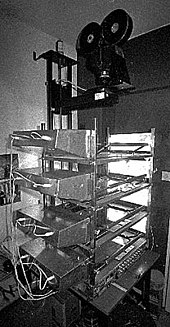Trick table
The animation table is the traditional workstation for recording analog 2D animation . But it is also used to record film titles and the recording of relatively flat objects, for example for scientific films.
In its simplest form, it consists of a worktop on which the animation is placed, a lighting device, and a tripod for the camera, which looks straight at the tabletop from above. This basic structure can be expanded by many elements, as long as there is enough space. Because of the close interlinking of camera and animation table functions, animation tables were often offered as a complete system by animation camera manufacturers.
Trick tables that do not contain a film camera but a photo camera are called reprotic tables .
construction
- The worktop is as comfortable as possible for the cameraman sitting or standing in front of it.
- The tripod is usually a camera column. The camera can be moved vertically on it in order to change the image section, since animation cameras usually only have lenses with a fixed focal length . Via a mechanical device which is automatically focus the camera tracked, as well as F-number changes, to compensate for the brightness difference between small and large receiving surface.
- On the right and left outside above the worktop there are 2, usually 4 or more lamps, which ideally shine on the work area at an angle of 45 ° and should illuminate it as evenly as possible.
In order to enable tracking shots in two-dimensional animated films, various elements of the trick table must be movable. Each movable element is called an "axis" of the trick table.
- The worktop can be moved in east-west and north-south directions (viewed from above). It is driven either by a hand crank or by motors that are addressed by computer control.
- A section of the worktop can be moved independently of the rest in an east-west direction. For example, a background can be drawn past behind a walking figure while the movement of the entire worktop changes the image section.
- The worktop can be rotated, the center of the rotation being on the camera axis.
In the case of trick tables with manual operation, the respective intervals of a movement must be set by hand on each axis. If the table is fully motorized, the computer control not only ensures that every necessary adjustment of an axis actually takes place, but can also calculate camera movements independently. The cameraman only needs to enter the start and end positions, possibly intermediate positions and information about how far movements should be accelerated or decelerated.
In order to place animation drawings correctly under the camera, it is equipped with a lamp that projects the image section that the camera “sees” exactly onto the worktop through the lens.
Multiplan camera
The term " multiplan camera " actually means a combination of camera and multi-level trick table. Lotte Reiniger already used such a structure , the name "Multiplan" was first given to the camera that was designed by Ub Iwerks for Disney in 1933 . One of the last Multiplan cameras in Germany was redesigned in 1994 for Gerhard Hahn Filmproduktion in Berlin and used for " Asterix in America ".
- Instead of a single level, the worktop, additional levels can be added. These consist of glass panes in stable frames, which are positioned on top of each other at a distance of between approx. 20 and 60 cm. Each of these levels has its own lighting and, in turn, its own movable axes.
Rear projection
Some animation tables are equipped with a "rear projection" device, ie a projector that projects a previously recorded film in such a way that the animation camera can record it together with the animation.
- In the worktop there is an opening in which two magnifying lenses are located one above the other, each face ground on one side. The rear projector is set up at such a distance that the image projected by it fills the opening as much as possible. The focus is on the plane between the two lenses. Although there is no projection surface such as a focusing screen, the camera can record the virtual image created there. This aerial image recording technique enables animation to be placed on the same plane as painted cels and illuminated without the projected image being affected by the lighting.
digitalization
Increasing digitization has made it possible for the cameraman to be able to carry out increasingly complex tracking shots quite comfortably, but the other hand movements when working on the trick table remained unaffected. The struggle against the dust clinging to the statically charged cels continued, and setting up a multi-level tracking shot took hours because the multiple lighting cast just as many unwanted shadows on the levels below. Complex recordings of this kind were therefore reserved for larger, feature-length animation projects.
The rapid development of software for digital image processing made it possible as early as the mid-1980s to create many effects on the computer that were previously only created on the trick table. In the mid-1990s, digital compositing was the standard in larger and increasingly smaller studios, and nowadays the usual effects can already be achieved in consumer video editing programs. As a result, many trick tables were scrapped, and even in animation schools like film schools, their rooms were gathering dust while computer workstations were overcrowded.

